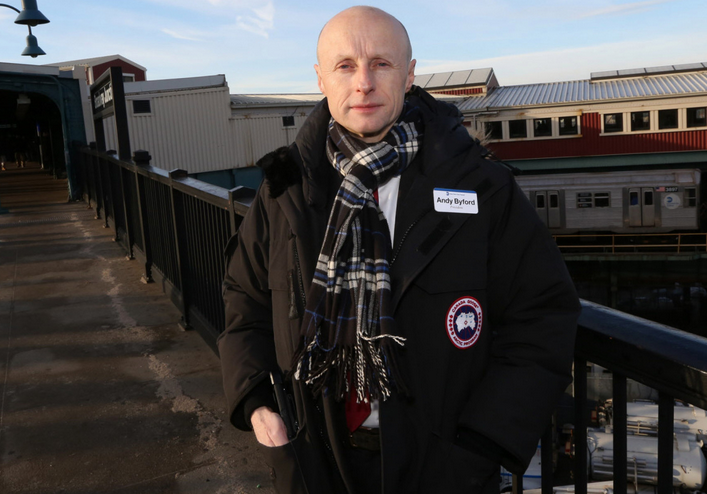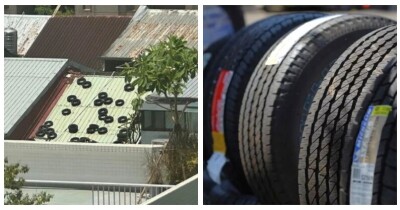New transit boss might have the toughest job in NYC

New transit boss Andy Byford's outreach effort will include takingevery subway and bus line.
It』s peak morning rush hour at the 23rd Street station on the 1line, and Andy Byford can』t help himself. He』s so detail-obsessedthat he is in danger of being trampled by fast-moving straphangersas they rush for their train.
The recently installed president of the New York City TransitAuthority bends down to pick up scattered copies of Metronewspapers and place them neatly back on their rack. He points tothe floorboards at the 23rd Street station that are fading.
「We could paint those black and at least show customers that weare on top of the details,」 he says while pointing out a dingystairwell. 「It』s grubby, just not acceptable.」
When he stops dead in his tracks to stare at a jumble ofcrisscrossed yellow safety tape precariously holding together abroken barrier (「That looks so hokey. We need to change it!」 hesays), one commuter angrily shoves him from the back.
「Move!」 he barks at the startled Byford, who is clearly not yetaccustomed to the sharp elbows of his newly adopted city.
Byford, 52, hails from England, and his Commonwealth manners areimpeccable.
「I』m so sorry,」 he mutters, slightly rattled by theexperience.
It』s a reflex apology, and it』s addressed to no one inparticular because the exasperated commuter has already maneuveredaround him, hell-bent on catching his train.
Dressed in a black suit under his Canada Goose parka andsporting the worn black leather shoes that have seen him throughhis previous tour of heading up the transit system in Canada』slargest city, the lanky Byford has the air of a mild-manneredaccountant heading to a Midtown office.
But it』s the bold blue and white oversize name tag pinned to hiscoat that gives him away. 「Andy Byford, President New York CityTransit,」 it reads.
Last month, as he set out to observe the morning rush-hourcommute in Brooklyn and Manhattan, Byford was greeted by some asthe subway messiah, the man who would finally fix the New York Citycommute. Smiling riders approached him to shake his hand and wishhim well.
That same morning, as he stood near a subway station in East NewYork, a passing motorist honked and yelled out, 「Good luck! Wereally need you!」
New York』s sprawling, rickety subway system, which dates back to1904, is a mess, plagued by aging equipment, legions of rats,frustrating daily delays and increasing numbers of homeless takingup residence in stations and on subway cars.
「We』ve got to take radical action,」 Byford tells The Post,adding that his first priority is to get the entire system 「runningin a reliable fashion」 before moving on to bigger projects such asmodernizing an ancient signaling system, introducing new trains andinstalling payment systems that allow riders to swipe debit cardsat turnstiles.
In January, there were 76,287 delays in weekday trains, up from60,455 at the same time last year, according to an MTA report. Theincrease in delays was attributed to a combination of emergencyrepairs, homeless people seeking shelter from extreme cold andcommuters trespassing on subway tracks.
Among Byford』s priorities are the much-needed repairs of theL-train tunnel that was devastated by Hurricane Sandy in 2012. Thatproject, scheduled to begin in April 2019, is expected to shut downthe L train — a major artery between Manhattan and Brooklyn — for15 months. Byford has already convened town halls in both boroughs,promising residents express buses, a ferry and new bike routes toreplace the train route once construction starts.
He is also in the midst of revamping the routes of Staten Islandexpress buses, which are taking too long to get commuters intoManhattan. Byford said he is working with Borough President JamesOddo and local residents to make sure the new routes are lesscircuitous and more efficient.
Byford says he will unveil a bold corporate plan in May. Rightnow, he is reluctant to say how long it will take him to addressthe most urgent problems but says he is already trying to shavethree months off the planned 15 months to repair the L-traintunnel. Other repairs and the purchase of new equipment will alsodepend on how quickly government moves to provide him the financinghe needs.












